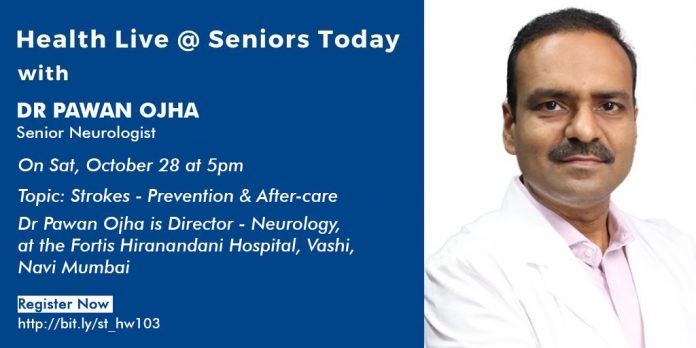Reading Time: 3 minutes
On 28 Oct, 2023, Seniors Today hosted their weekly Health Live webinar with Dr Pawan Ojha, a Senior Neurologist who spoke on and answered questions about Strokes- Prevention and After- care. This weeks’ session was conducted to celebrate World Stroke Day which falls on 29 Oct, to talk about and spread awareness about stroke in the general and affected population.
Dr Pawan Ojha is a well-known neurologist with experience of over 20 years in the field. He completed his DM (Neurology) and DNB (Neurology) through Grant Medical College (Mumbai) and National Board of Examinations (New Delhi). He ranked 1st in DM Neurology examinations conducted by University of Mumbai. He completed a Fellowship Programme in Stroke Medicine under the Calgary Stroke Programme, University of Calgary, Canada. He is the President of Association of Neurological Clinical Research (India) & Ex secretary of Maharashtra Association of Neurology. He is also a Vice President of Mumbai Stroke Society. He is also the Executive Committee member of Indian Stroke Association.
His areas of expertise include: Stroke Treatment, Headache Management and Vertigo Treatment.
Stroke is a brain disease, to the layman, in general. We now know that a heart attack is also called a myocardial infarction, in medical terms, which is now common knowledge as well. Similarly, there are diseases of the brain and its blood supply which are called strokes. It is also called paralysis, hemiparesis, etc. but what needs to be understood is that it is different from fits or seizures or convulsions.
Stroke is a concern with the blood supply to the brain which can lead to paralysis.
The brain is divided in to the following lobes:
- Frontal lobe: responsible for thinking, problem solving, speaking, motor control
- Parietal lobe: related withs sensation of pain, pressure, vibration
- Temporal lobe: associated with hearing and face recognition
- Occipital lobe: associated with vision
All of these lobes and the information that they relay are interlinked. Adn all of these lobes are supplied by the arteries of the brain, if one of the parties is blocked at a point, no area distal to the site of blockage will be supplied, leading to death of the said area. There is however some time between the time of block formation and the ischaemia of the brain tissue supplied by it. It is important to intervene between that window. If not, it can lead to permanent damage to the area of the brain leading to permanent loss of function- motor and/ or sensory of the concerned area, and often risk of death.
Occasionally, if the cause for the first stroke is not recognised, it can lead to recurrence of strokes in the future as well. The chances of recurrence of stroke in the next few months rises by 25%. The recurrent stroke can be greater with respect to the area affected or the damage caused.
All patients of stroke do not only present with the weakness of arms/ limbs, tingling or numbness or the limbs. Some patients can also have issues with body balance.
Most strokes lead to involvement of the face and arms, this can lead to drooping of the face, speech associated issues- such as talking or inability to understand what is being said.
In case of suspicion of stroke, time is of the essence, which is why reaching a hospital as soon as the symptoms present, is important.
Golden hour of stroke is between 1.5 hour to 4.5 hours after the first symptom, and if the patient is given treatment within these hours, it can potentially save the patient.
A CT scan of the brain with help us decide if its
- Haemorrhagic stroke
- Ischaemic stroke
In case of ischaemic stroke due to an occluded blood vessel, the treatment involves identifying the blockage and to resolve the blockage/ clot with the help of 2 injections to restore the blood supply. This is called thrombolysis.
Some other medical conditions which can mimic a stroke:
- Hypoglycaemia- blood sugar levels below 70 mg/dL
Chameleons of stroke are medical conditions which can hide a stroke:
- Acute vertigo
- Movement disorders
- Isolated confusion
- Sensory anomalies
- Acute Amnesia
- Shaking Transient Ischaemic Attack
Good rehabilitation with the help of physiotherapy and brain stimulation exercises helps a patient get better after an episode of stroke.
Occasionally, that damage to the area of the brain is high, this is when we use devices such as trans cranial magnetic stimulation device which is used to stimulate the brain areas and to alter the response of the uninhibited areas.
As we age, our heart also ages. This can lead to dysfunction in the brain leading to formation of clots which can get enlodged in the brain arteries leading to strokes. Atrial fibrillation is a common cardiac condition which is associated with thrombus formation.
Preventive measures:
- Maintain your blood pressure. Be compliant with your medications if you are on anti hypertensives
- Maintain your LDL at a value of less than 100 mg/ dL, triglycerides below 150 mg/dL, HDL more than 40 mg/dL (men) more than 50 mg/dL (women)
- Try reducing your weight by 5% in individuals who are obese/ overweight
- Stop smoking
- Daily exercise for at least 30-45 mins
- Dietary modifications: DASH diet, mediterranean diet, vegetarian diet. Low salt, low oil diet.








